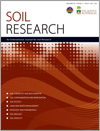SR18105A new Australian record of a Parajapidae (Diplura): a potential pest of wheat
A root pest of cereal was found for the first time in Australia in a wheat crop in central New South Wales. It was identified as Parajapyx isabellae and is worldwide in distribution. Species distribution was restricted to soils below 5 cm and almost exclusively in minimum tillage plots.





